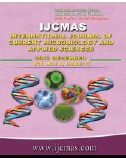


 National Academy of Agricultural Sciences (NAAS)
National Academy of Agricultural Sciences (NAAS)

|
PRINT ISSN : 2319-7692
Online ISSN : 2319-7706 Issues : 12 per year Publisher : Excellent Publishers Email : editorijcmas@gmail.com / submit@ijcmas.com Editor-in-chief: Dr.M.Prakash Index Copernicus ICV 2018: 95.39 NAAS RATING 2020: 5.38 |
Fungi are opportunistic organisms with wide geographical distribution and can also be found in the hospital environment. These microorganisms can cause infections, especially in immunocompromised patients. The aim of this study was to evaluate airborne fungal contamination in two neonatal intensive care units (ICU) of a public hospital before and after cleaning. The technique of Petri dishes exposure containing Sabouraud agar with 50mg/L chloramphenicol was used for sample collection. Air conditioning filters were also sampled using a sterile swab for fungal collection. The identification of fungal isolates was performed by observing macroscopic and microscopic structures. A total of 1305 colony forming units was isolated, where: 718 (55.0%) were isolated before neonatal ICU cleaning and 587 (45.0%) after cleaning. Forty-two species belonging to 24 genera were identified, being Cladosporium cladosporioides, Penicillium aurantiogriseum and Aspergillus oryzae the most frequent species in the analyzed samples. The presence of pathogenic fungi in ICUs demonstrates the need for constant monitoring of indoor air quality in order to better control airborne contamination in hospital environments.
 |
 |
 |
 |
 |